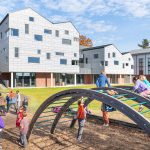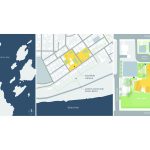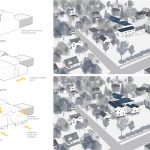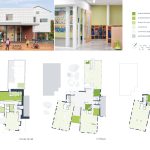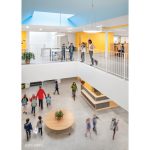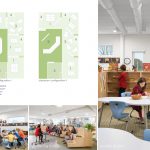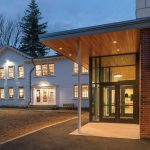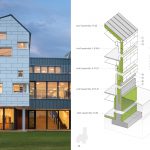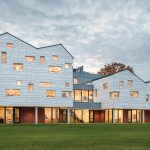Waynflete Lower School
Project Name
Located in Portland’s Western Promenade Historic District, the new 34,000 SF Lower School was designed to reflect the scale and rhythm of neighboring residences. The project merges the School’s 121-year history with its future, by incorporating its original building, Founders Hall with a new innovative, Passive House certified school building.
The new School replaces an outdated white brick addition built in 1968. Undersized and overused, the former addition was a confusing, multi-level conglomeration of several buildings that separated and isolated the school’s four learning age groups.The new building is designed to integrate the four groups (Early Childhood, K/1, 2/3, and 4/5 grades) and organize their “habitats” around a central lobby and atrium that runs right through the middle of the building, connecting the upper level playground at the front entrance with the lower level playfield behind the building.
The new building has two wingsjoined by the atrium and a shared classroom, allowing natural daylight to flow into three sides of each classroom grouping. The building includes flexible learning spaces, as well as an art studio and after school spaces.
The building was designed to achieve three goals:
- To create a sense of shared community that would allow all students, their families, and faculty to be together on a daily basis. The shared entrance lobby visually connects all four group classroom areas, and the stepped atrium that can seat 100 connects the entrance playground with the field behind the school.
- To create a sense of identity and cohesiveness, fostering a sense of familiarity and security within each of the four classroom groupings. Each grouping has its own gathering space, cubbies, and bathrooms, with its own distinctive sense of place and relationship to the shared community spaces.
- To create opportunities for small group and individual experiences that are age appropriate and encourage the children to develop greater confidence and self-expression. Windows that go to the floor that the children can literally walk into, climbing lofts that younger children can navigate for quiet time, corner windows and window seats that connect to the out-of-doors, and colorful spaces all encourage creativity.
The building has a high-performance exterior envelope and high efficiency mechanical and lighting systems. It is designed to achieve Passive House certification (pending), that reduces the energy use to 80% less than energy code requirements.
The building was completed in 2018 at a cost of $8.6M ($253/SF).
COTE Measure #1: Design for Integration
The Lower School building was designed to meet the highest goals for the education of students age 3-10, while adhering to the building committee’s directive to deliver a building that is both environmentally and fiscally responsible.
Reflecting the school’s educational and social values, the new building provides a unique environment for students of all races, religions, and backgrounds to gather in a place where they can learn as a group but are also celebrated as individuals. Students learn from each other in an integrated, multi-age setting that encourages collaboration, respect, and camaraderie. The building was designed to reflect and encourage these interactions, most notably in the shared central spaces of the building (the double height lobby, the stepped atrium gathering space, the outlets to the playground and field, and the shared art, music, cooking, and after-school classrooms).
Despite its remarkably low cost of $253/SF including sitework, the new school building is uncompromising in its quality and performance. With triple glazed uPVC windows positioned to optimize views of specific age groups in each space, the design team was able to create unique connections to the outdoors while staying within budget. Unlike most traditional lower school buildings, this building was designed with the student experience in mind and aims to provide opportunities for students to explore, stretch, and find their own independent expression.
Once certification is complete this will be the largest Passive House educational building built in Maine to date. As an addition to an existing 150-year-old building on a campus with more than 120 years of history, this approach has broad appeal for balancing forward-thinking building technology with an appreciation of our cultural heritage in the built environment.
COTE Measure #2: Design for Community
The ultimate in community building: young children learning and playing together in a creative, safe environment. We also created an entry sequence where children, parents, and teachers could interact comfortably.
The community engagement was highly collaborative. A partnership was formed between the design team and the school community that exists to this day, almost a year after completion. We engaged with the teachers and administration on the project design for more than five years, working closely with them to define the goals and character of the proposed new Lower School building, and reviewing alternative approaches and strategies as we searched for the design solution that worked best for their school community.
We also worked closely with the surrounding neighbors and the Western Promenade Historic District, that the School sits within, to design the 34,000 SF building in a way that was compatible and complementaryto the scale and character of the neighborhood.
Walk Score: 71. Most visits can be accomplished on foot.
COTE Measure #5: Design for Economy
At $253/SF, including sitework, the new Lower School building was very cost effective for a building of its quality and performance (Passive House). The building performs at approximately 80% better than an energy code compliant building of similar size and complexity, saving on energy costs every year for the rest of its life.
Early on in the design process, an analysis was done to determine the additional cost of designing for Passive House certification. At a cost of only $10.50/SF more than an energy code compliant building, and with a payback of less than 6.2 years, it was an easy decision for the school trustees to authorize going ahead.
Overall, cost-effective design decisions included using the slope of the site to reduce the scale of the building relative to the surrounding residential neighborhood, using structural insulated panels for the walls and roofs to provide superior energy performance and shorten construction time.
For comparison purposes, very few similar educational buildings with Passive House performance requirements have been built in our region. The two that we know of were built for $220/SF (in 2014) and $292/SF (in 2018), including sitework.
COTE Measure #6: Design for Energy
The new Lower School addition was designed and built to meet Passive House standards and is in the process of being certified to PHIUS +2015 requirements. Using eQUEST in combination with WULFI Passive software, energy modeling was done to analyze the thermal envelope as well as assess condensation risks and ensure comfort levels in Maine’s climate zone 6 environment. Natural Daylighting strategies, along with occupancy sensors and LED fixtures were used to reduce heat gain from lighting load and maximize occupant comfort and control. Predicted Lighting Power Density output is 0.34 W/SF. Energy recovery ventilation units were used with Variable refrigerant flow units to quietly and efficiently heat and cool the building and maximize occupant control.
The Site energy use intensity for the building is estimated to be 10.6kBTU/sf/YR, as modeled in WULFI Passive. This places the Lower School building in the 1% percentile for performance of existing buildings nationwide. The median rate for the s building type, climate and program is approximately 36.8 kBTU/sf/YR in comparison.
Predicted Net EUI is 12.6 kBTU/sf/YR and Carbon Emissions are estimated at 2.08 LB/SF/YR.
This project uses approximately 66% less energy than the national median for this building type.
COTE Measure #7: Design for Wellness
Wellness for the children was a driving force behind the design of this building. The School educates 325 students, age 3-10, from pre-school through 5thgrade in four classroom groupings: PS, K/1, 2/3, and 4/5. There are also shared classroom spaces for cooking, music, art, after-school, and gathering.
100% of Teaching Spaces with Direct Views and Operable Windows:
All of the classroom and shared spaces have views to the exterior; all of the classroom spaces have windows on three sides, and all of the classroom and shared spaces are within 30’ of operable windows.
100% of Teaching Spaces with Adequate Light Levels:
Daylight models were studied to insure the window pattern and locations provide ample daylighting for the classrooms. All of the classroom and shared spaces have adequate daylight during the normal classroom hours without the use of artificial lighting. Teachers can adjust the lighting levels in their individual “habitats” if they choose to, for example to show a movie, etc.
Thermal Comfort Control:
Each classroom/age grouping includes four distinct teaching areas. The teaching areas (habitats) are open to each other, and the shelving units that define their edges are all on casters for easy reconfiguration and flexibility. Teachers have the ability to adjust the heating and natural ventilation from each classroom area, although they are not encouraged to adjust the thermostats. Using Variable Refrigerant Frequency Heat Pump Units in combination with and Energy Recovery Ventilating unit, mechanical operations are quiet and constant.
COTE Measure #9: Design for Change
The School reused the oldest building on their campus, Founders Hall, re-purposing it for new use as pre-school classrooms downstairs and 4/5 classrooms upstairs. The project is a model of adaptability, illustrating how to cleverly reconfigure and add onto an existing school building to create a unified educational community for young children. The project includes the 6,000 SF renovated Founders Hall and the 28,000 SF new Lower School additions. Founders Hall represents 18% of the total floor are of the Lower School.
Flexibility was paramount to the School during the design process. They wanted the classroom spaces to be universally adaptable to a diverse range of educational uses and age groups in the future, should the configuration and numbers of their student age groups change.
Designed to Passive House, the building is extremely resilient in terms of thermal comfort. We do not have any calculations for how long the building would stay warm during a power outage, but based on the high performance of its exterior envelope (Walls range from R-40 to R-60, depending on assembly, roof is R-60, slabs are R-20, Windows have a u-0.15 rating. Our target air infiltration rate is 0.05 cfm50/sf), the building could easily provide shelter and comfortable conditions for several hundred people in the event of a power or weather emergency.

